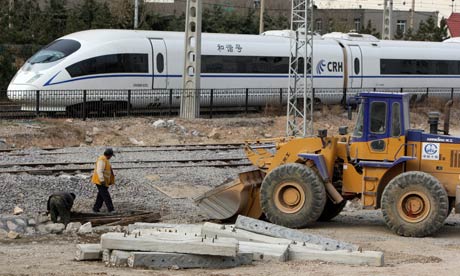
A high-speed train travels past workers building an electric railway line at a construction site in Qingdao city, in eastern China. Photograph: Wu Hong/EPA
In 1825, William George Allen, council to Britain's first inter-city railway, the Liverpool and Manchester, predicted that railways might "prove of the greatest advantage to our trade and commerce; and which, if we do not adopt it, will be adopted by our rivals." He was not wrong, and in the 19th century the spread of railways across Britain and America contributed to both nations' transformation into industrial world powers. Indeed, recent estimates have suggested that without the quicker and cheaper travel provided by the railways, British GDP would have been 14% lower in 1912.
The current thinking of the Chinese government is strikingly similar to Allen's. Over the past 20 years it has invested heavily in the railways to enable them to be a supporter and facilitator of economic development. However, in the last six, investment levels have reached new highs. An investment programme worth about ?80bn has grown the country's network from 78,000km at the end of 2007 to an estimated 110,000km at the end of this year. This was supplemented by the announcement in 2008 of a further ?74bn to enable the network cope with increased traffic until 2020.
This investment has generally considered to have served its purpose. Similar to most railway development, some expenditure has been on prestige projects, such as the world's longest high-speed line between Beijing to Guangzhou, which is due to open on 26 December. However, the Chinese network's primary role has not been to ferry business people, but to enable the easy movement of goods and labour. Indeed, passenger numbers increased by 4.6% in November, and while in 2011 China's railway network only constituted 6% of worldwide route mileage, it carried 25% of its workload. Therefore, further investment in railways will very likely continue to facilitate China's economic development; just like in Victorian Britain and America.
There is, however, a good possibility that China's railway will be built to do this more efficiently than those in 19th-century Britain and America. In these countries the planning of routes was almost completely left to the private companies, with very little state interference. Consequently, by 1880 Britain could claim to have a largely comprehensive network; but because of competition and speculative building it was considerably over-capitalised and possessed excessive route mileage. Indeed, Mark Casson has estimated that if the state had planned Britain's railways, by 1914 they would still have been able to comprehensively serve the nation's needs for 25% less cost and with a route mileage 7,000 miles shorter than the real total of 20,000 miles.
Yet, because the Chinese government determines when and where a line is constructed, it is likely to avoid such problems. Its railway planners are not encumbered by competitive line building, speculative bubbles, struggles over territory or unrealistic expectations of profit; factors that shaped Britain and America's haphazard railway network. Rather, it can theoretically link two cities, ports or factories when required, providing quickly and cost-effectively a network that is shaped to the needs of the economy, rather than private interests.
But furthermore, the high engineering standards of modern railways, combined with the nation's mixed terrain and vast distances between cities, mean that only the government has the resources to speedily and adequately augment China's railway network to support the nation's quickly growing economy. While total investment in Britain's railways between 1825 and 1910 would be worth approximately ?110bn today; this is far less than the sums expected to be invested in Chinese railways in only 12 years between 2008 and 2020. Thus, had the Chinese government not chosen to invest staggering amounts in its railways, this may have considerably held back the nation's economic progress.
Therefore, state planning and investment may mean that by 2020 China will possess a railway system that contributes more to growing and supporting its economy than those Britain and America developed in the 19th century.
Source: http://www.guardian.co.uk/commentisfree/2012/dec/19/china-state-planned-railway-age
Colin Powell Tyrann Mathieu noaa Jessica Ridgeway jessica biel ipad mini Kevin Krim
No comments:
Post a Comment
Note: Only a member of this blog may post a comment.